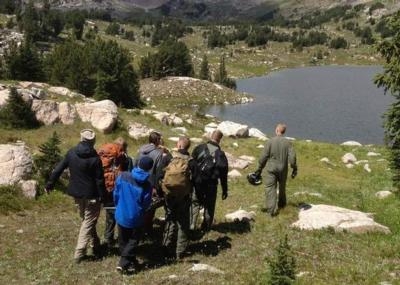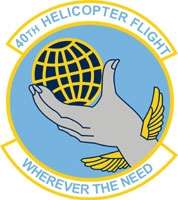Total Now At 396 After Two Rescues Last Week
The 40th Helicopter Squadron based at Malmstrom AFB in Montana added two more rescues to its successful search and rescue count this past week bumping the total up to 396 saves.

The Air Force Rescue Control Center called in to the squadron Aug. 3 at 0730 local requesting helicopter support for a search and rescue in the Absaroka-Beartooth Wilderness. After only an hour, a crew of four launched the aircraft; Capt. Erik Greendyke as the aircraft commander, Maj. John Beurer as the co-pilot, and Master Sgt. Scott Andrews and Staff Sgt. Michael Frank as the flight engineers.
“We get called on SARs if other organizations like local SAR [teams], local police or the forest service aren’t able to save the person themselves (sometimes the reason is environmental or lack of equipment/resources) so many of the SARs we get called to help out with are a pretty bad situation to begin with,” said Capt. Cindy Tope, UH-1N pilot.
The SAR was called in as a medical emergency. A 14-year-old boy from Minnesota was on a 12-day hiking/camping trip when he was suspected to have developed appendicitis. The Sweet Grass County Sherriff and search and rescue team had been en route for 18 hours and were still hours away from the boy making air extraction a faster and much more viable approach for the emergency. In a hurry, the crew carried a stokes litter 0.6 nautical miles over rough terrain to Mirror Lake, 45 miles south of Big Timber. The boy was extracted by the litter and transferred to an awaiting ambulance at Big Timber Airport where he was then transported to a hospital to receive further medical treatment.
The rescue took 10 hours from start to finish including 4.5 hours of flight time.

The second search and rescue request was called in to the squadron at 1830 local time on Aug. 5 and a different crew of four launched the following morning at 0730. “We weren’t able to leave until the next morning due to high altitude and power considerations,” Tope said. “We needed it to cool off before we would have the power to accomplish the approaches at the altitude of the coordinates we were given.”
Tope was the co-pilot for the rescue along with Capt. John Mahaney, aircraft commander; Staff Sgt. Michelle Bresson, flight engineer; and Capt. Vanessa Pearson, flight doctor. They all headed back to the Absaroka-Beartooth Wilderness, near Mt. Peal, to extract a hiker who had been stranded for a few days. A 63-year-old man had gotten caught in a saddle between two steep peaks and didn’t have the equipment necessary to climb out of the steep and rough terrain. Carbon County had sent out a ground SAR team to try and reach the hiker the day before, but with the exception of phone and radio, were unable to reach him.
According to 40th HS officials, “The call for help had been sent out through a GPS spot system and didn’t include any clues as to the condition of the hiker, but a civil SAR plane flew over his coordinates, located him and reported that he had ‘stood and waved’ so we assumed he was ambulatory.”
The crew landed the aircraft to extract the man, but not without a few challenges first. “Slopes, for the most part, exceeded landing limitations for the helicopter, so the flight engineer played a critical role in taking the helicopter to one of the few spots where we could land and pick up the survivor,” officials said. “This was probably one of the biggest achievements of the day since, if landing is possible, it is much safer to the person being rescued, as well as the helicopter and its crew, than attempting a hover to hoist the person out, especially at such a high altitude. The site elevation was 10,400 feet.”
After landing the aircraft, Pearson evaluated the hiker’s medical condition before prepping him for transport to Red Lodge where the Carbon County SAR team, medical personnel and the man’s family were waiting.
Throughout the rescue, the crew discovered that the man was a Vietnam veteran and he was familiar with UH-1N Hueys, but they were surprised to learn it was also his 64th birthday.
The crew gives credit of every successful search and rescue mission to the training they receive prior to answering these calls for help. New pilots and flight engineers are pushed to their limits during training so that they are prepared for anything that comes their way.
”The reason we can complete these difficult SARs is because of the excellent training we get,” Tope said. “Hopefully the training is enough so that once that crew is on their own, a difficult SAR isn’t the most difficult thing that crew has ever done; however, if a scenario exceeds our capabilities, or the aircraft capability isn’t enough to meet the demands of the environment, our training gives us the experience to recognize it.”
(USAF Image Members of the 40th Helicopter Squadron along with other hikers transfer a 14-year-old boy to the on-sight aircraft for transportation to a hospital Aug. 3. U.S. Air Force photo/Capt. Erik Greendyke)
 Unfortunate... ANN/SportPlane Resource Guide Adds To Cautionary Advisories
Unfortunate... ANN/SportPlane Resource Guide Adds To Cautionary Advisories ANN FAQ: Turn On Post Notifications
ANN FAQ: Turn On Post Notifications ANN's Daily Aero-Term (04.29.24): Visual Approach Slope Indicator (VASI)
ANN's Daily Aero-Term (04.29.24): Visual Approach Slope Indicator (VASI) ANN's Daily Aero-Term (04.28.24): Airport Marking Aids
ANN's Daily Aero-Term (04.28.24): Airport Marking Aids ANN's Daily Aero-Linx (04.28.24)
ANN's Daily Aero-Linx (04.28.24)




